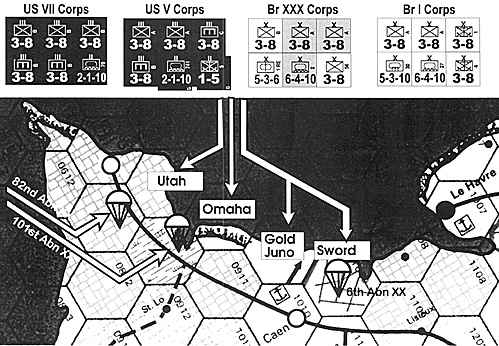Initial Phase
Weather
The beautiful weather of May disappears when a persistent high-pressure system over the Azores begins to break up. Storms force a postponement of the operation by a day. Any further delay means a major delay until the tides and moon are again favorable. Suddenly a brief window appears and 'Eisenhower decides to go. In terms of Europa, the weather roll is a '6' for Clear weather. The roll for sea conditions is a '5' for Calm. [The tense pre D-Day weather situation will become one the most celebrated issues of the battle. Europa's two-week scale cannot recreate it, but the roll of '5' is dangerously close to a '6' meaning Rough Seas.]
Planning
The Allies plan an airdrop for the Jun II turn consisting of 1st British Airborne XX HQ, 1st Air Landing X, and 1st and 4th Parachute X's in hex 17A:1110.
Movement Phase
Bombing of Coastal Defenses
Allied air units conduct coastal defense bombing missions on Cherbourg until its CD is reduced to '1'. This reduces the CD combat zone to only its own hex and it cannot interfere in the landings at UTAH in 17A:071 1. [Actually, the Cherbourg CD is well out of sight and range of UTAH Beach, which was on the border of 17A:0711 and 17A:0811. It is easy enough for the Allies to allocate some air units to its suppression without the addition of a special rule 9can be taken to represent some of the invasion morning bombardment of installations all along the invasion coast.]
Naval Movement
The Allied units move, at night, to their planned invasion hexes. Allied task forces clear the mines in 17A:0710 with no losses (common SF player usage is to use the French TF for this task).
The US Ranger battalions conduct a coastal raid on the 1pt of CD in 0810 (the batteries at Point du Hoc). They roll a '5' for success.
The British commando brigade in hex 17A:1009 also carries out a successful coastal raid on the 1pt of CD (the Merville batteries). [The batteries were actually silenced by airborne units].
Air Drops
The three Allied airdrops (of 13 total units) are all made at night, the Americans coming in across the Continent from the west. The details of the individual airdrops appear below.
Axis Reaction Movement
The Germans make four reaction rolls for amphibious landings and two rolls for airborne hexes (using the scenario special rules). Two are successful. The 6th Fallschirmjager Regiment activates at St. Lo and moves one hex into the Douve Estuary (17A:0811) to battle the 101st Airborne. The 30th Mobile Brigade at Coutances in hex 17A:0913 activates and moves to St. Lo (17A:0912), blocking any American exploitation into that hex. Most importantly however, the rolls for the 21st Panzer are unsuccessful.
Combat Phase and Exploitation Phases
The descriptions of the landings, combat, and subsequent exploitation phase (mainly reinforcement of the beachhead) is presented for each target hex.

Battle for Normandy Europa as History
- The Players
The Plans
The Game (Allied June I 1944 Turn) Set Up
The Game (Allied June I 1944 Turn) Combat: Douve and Carentan
The Game (Allied June I 1944 Turn) Combat: Merderet Valley
The Game (Allied June I 1944 Turn) Combat: Utah Beach
The Game (Allied June I 1944 Turn) Combat: Omaha Beach
The Game (Allied June I 1944 Turn) Combat: Gold and Juno Beach
The Game (Allied June I 1944 Turn) Combat: Sword Beach
The Game (Axis June II 1944 Turn)
The Game (Allied and Axis Jul I 1944 Turn)
The Game Poised for a Breakout
Back to Europa Number 59-60 Table of Contents
Back to Europa List of Issues
Back to MagWeb Master Magazine List
© Copyright 1997 by GR/D
This article appears in MagWeb (Magazine Web) on the Internet World Wide Web. Other military history articles and gaming articles are available at http://www.magweb.com